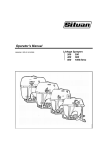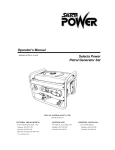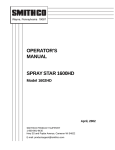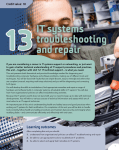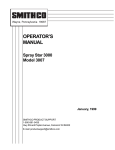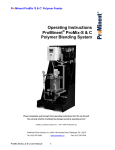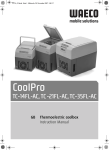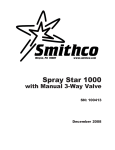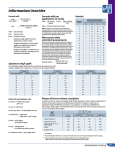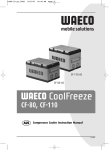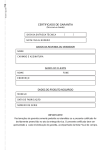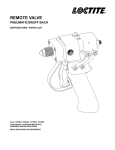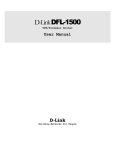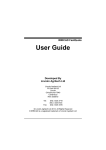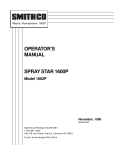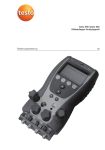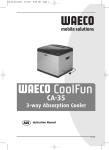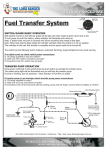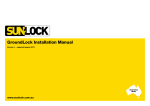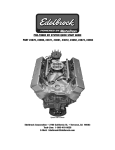Download Operators Manual
Transcript
Operators Manual MANLINK-4 REV A 16/09/04 400L / 600L Pasturepak Linkage Sprayer SILVAN AUSTRALIA PTY. LTD. ABN 48 099 851 144 VICTORIA (HEAD OFFICE) QUEENSLAND 89 Lewis Rd, Wantirna South 3152 44 Lysaght St. WESTERN AUSTRALIA Hanwell Way Telephone: (03) 9887 2788 Acacia Ridge 4110 Bassendean 6054 Facsimile: (03) 9887 1035 Telephone: (07) 3345 9500 Telephone: (08) 9279 0800 Spare Parts Facsimile: (03) 9887 1637 Facsimile: (07) 3345 9511 Facsimile: (08) 9279 0810 www.silvanagcess.com Introduction Silvan is an Australian owned company specialising in supply of crop protection equipment to primary producers. A leader in the design of agricultural sprayers, the company was established in 1962 and has grown to become the largest manufacturer and supplier of crop protection equipment in Australia. Our operations are fully accredited to the international quality standard ISO 9001 and we are extremely proud of our reputation for quality products backed by quality service. Your investment in a Silvan sprayer is an investment in quality. This manual covers the 400L and 600L Pasturepak units, which have been designed and manufactured to provide a high standard of performance and safety and incorporate many innovative features. To ensure continued efficient performance and safe operation of your sprayer, you need to read this manual thoroughly and fully familiarise yourself with all aspects of the sprayers operation, maintenance and safety procedures. Now that you are a proud Silvan owner, all our services and dealer support are available to you should you need them. We assure you of our best attention at all times. No liability can be accepted for any inaccuracies or omissions in this publication, although due care has been taken to make it as complete and accurate as possible. The information, illustrations and technical data were considered to be correct at the time of preparation. In accordance with our policy of continuous development, Silvan Australia Pty. Ltd. reserves the right to make changes at any time without notice. Contents Warranty About your warranty. New Product Warranty Policy. 2 3 Safety Information 4 Specifications 7 Operation Attaching the tractor to the PTO drive Starting the Sprayer 3 outlet control, Fresh Water Tank and Toolbox Spray Booms Spray Guns, Hose Reels and Foam Marker 8 8 9 9 10 General Spraying Information When to spray, field patterns, droplet size. Nozzle height, application rate, ground speed 11 11 Calibrating the Sprayer Testing, varifying calibration, nozzle maintenance Nozzle selection 12 13 Lubrication and Maintenance 15 About Your Warranty Silvan Australia Pty. Ltd. welcomes any warranty repair and apologises to you for any inconvenience caused. See the next page for the statement of your legal warranty coverage. The following information will assist your understanding of warranty procedures. Any authorised Silvan dealer service outlet can perform warranty repairs for you, however, we recommend that such repairs be carried out by the Dealer from whom you bought the machine. Most warranty repairs are handled routinely, but sometimes requests cannot be accepted under warranty. Normal wear and tear is not covered by warranty nor does warranty apply if a product failure can be attributed to abuse or neglect. Whilst Silvan will abide by its warranty policy under all genuine circumstances, we must emphasise that such can only apply when our equipment has been used in applications for which it was designed and manufactured and that a reasonable degree of care and common sense has been exercised by the operator. Warranty Repair Site. The warranty provides for repairs to be carried out at the servicing dealers normal place of business. An owner may elect to have repairs carried out at his own residence but, whilst Silvan will accept the actual repair cost of the failed component(s), the travelling costs will not be covered under warranty. Items Not Covered By Warranty. The warranty does not allow for the cost of the following items: These are the responsibility of the owner. 1. Labour to travel to and from a brokendown machine or for any distance charges. 2. Labour premiums that might apply for any repairs that are made outside the dealers normal business hours. 3. Transportation costs of the machine to and from the service outlet. 4. Freight costs to get parts to and from the service outlet. 5. Telephone and fax calls made by the owner in connection with the warranty repair. New Product Warranty WARRANTY POLICY Silvan Australia Pty. Ltd. warrants to its authorised dealer, who in turn warrants to the original purchaser (owner) of each new Silvan product, that it will repair or replace, without charge for labor or parts, any defective or malfunctioning parts in accordance with the warranty limitations and adjustments schedule below. PRIVATE DOMESTIC - 12 MONTHS PRIVATE and COMMERCIAL AGRICULTURE - 12 MONTHS AGRICULTURAL CONTRACTORS – 6 MONTHS GOVERNMENT and MUNICIPAL DEPARTMENTS DEPTS- 6 MONTHS ALL NON-AGRICULTURAL APPLICATIONS - 3 MONTHS HIRE COMPANIES – 3 MONTHS The warranty period will begin on the date the product is delivered to the first retail purchaser. THIS WARRANTY COVERS: · · · · · Only conditions resulting from defects in workmanship or material under normal use and service. THIS WARRANTY DOES NOT COVER: Conditions resulting from misuse, negligence, alteration, accidental damage or failure to perform normal maintenance services; Any product which has been repaired by other than authorised Silvan Australia Pty. Ltd. service outlet so as , in any way in the sole and absolute judgement of Silvan Australia Pty. Ltd. to affect adversely its performance and reliability; The replacement of wear and tear items such as diaphragms, V-Belts and ground engaging components; Loss of time, inconvenience, loss of use of the product or other consequential damages. The repair of defective products qualifying under this warranty will be performed by an authorised Silvan Australia Pty. Ltd. Service outlet within a reasonable time following the delivery of the product, at the cost of the owner, to the service outlet’s place of business. The product will be repaired or replaced, using new parts sold by Silvan Australia Pty. Ltd. The owner is responsible for the performance of regular maintenance services as specified in the Owners/Operator’s Manual applicable to the product. · THIS WARRANTY IS THE ONLY WARRANTY APPLICABLE TO SILVAN AUSTRALIA PTY. LTD. NEW PRODUCTS AND, TO THE MAXIMUM EXTENT PERMITTED BY LAW, IS EXPRESSLY IN LIEU OF ANY OTHER WARRANTIES EXPRESSED OR IMPLIED, INCLUDING ANY IMPLIED WARRANTY OF MERCHANT ABILITY OR FITNESS FOR A PARTICULAR PURPOSE. · SILVAN AUSTRALIA PTY. LTD. DOES NOT AUTHORISE ANY PERSON TO CREATE FOR IT ANY OTHER OBLIGATION OR LIABILITY IN CONNECTION WITH THESE PRODUCTS. · SUBJECT ONLY TO LEGISLATIVE OBLIGATIONS TO THE CONTRARY, SILVAN AUSTRALIA PTY. LTD. SHALL NOT BE LIABLE FPR INCIDENTAL OR CONSEQUETIALDAMAGES RESULTING FROM A PRODUCT PERFORMING IN BREACH OF THIS WRITTEN WARRANTY Safety Information. Before operating the sprayer read the following safety instructions. Failure to comply with these warnings may result in serious injury or death. · · This sprayer is designed and manufactured solely for the purpose of applying agricultural chemicals to crops. Under no circumstances should it be used for any other purpose. · Before using the sprayer carefully read and ensure you understand the contents of this manual and any other manual supplied with the sprayer. · Before operating the sprayer, read all the safety warnings, which are carried on various parts of the machine. Refer to the next page for a location diagram and the wording of these warnings. · Never allow an inadequately trained person to attach or operate the sprayer. · Do not operate the sprayer whilst wearing loose clothing, unrestrained long hair, jewelry or anything which could become entangled in rotating components or limit your vision. · Wear ear protection when operating the sprayer on a tractor which is not fitted with a sound proofed cabin. · Ensure the linkage capacity of the tractor is suitable for the loaded mass of the sprayer. Refer to the tractor operator’s manual for safe working loads and relevant tractor safety instructions. · Exercise extreme care when operating in hilly or uneven terrain to ensure proper stability. Refer also to the tractor manufacturer’s operating and safety instructions. · Do not operate the sprayer at speeds greater than 540 PTO rpm · Do not operate the sprayer without all of the tractor and sprayer safety shields in place. Carefully check that PTO and driveline shields are correctly installed. · Stop the tractor PTO, apply the parking brake and switch off the tractor engine before approaching the sprayer and performing any work on it. · Disconnect the PTO shaft at the tractor and ensure the sprayer is properly supported before performing any maintenance work. · Before use of any chemicals refer to the chemical manufacturer’s label and safety instructions for safe handling procedures and correct method of use. Always use the recommended personal protective clothing and equipment. · Always wear gloves when removing and cleaning filters · Dispose of empty chemical containers in accordance with the instructions supplied by the chemical manufacturer · Ensure that all operators and associated personnel are familiar with the legal regulations and codes of practice that apply to the safe use and storage of spray chemicals. · Ensure chemicals are kept away from fresh water tank. Never drink water from fresh water tank. Decal Positions 400L DEC 48 DEC 12 DEC 10 DEC 13 399 14 1000 Decal Positions 600L Specifications This sprayer is designed and manufactured solely for the purpose of applying agricultural chemicals to crops. Under no circumstances should it be used for any other purpose. Spray Booms (Optional) Field Galvanized steel truss 6 or 8m Three section horizontal fold Tank Low-line designed tank constructed from Polytuff impact resistant polyethylene. Capacity 400 / 600 litres with calibrated external sightline. 255mm diameter screw down lid with basket strainer. 15 litre fresh water tank with on/off tap. 4 litre toolbox with easy access Polyethylene lid. Continuous by-pass agitation to bottom of tank. Fieldmaster Galvanized steel truss with nozzle protection 10 or 12 m Three section horizontal fold. Double fold outer arms Suspension and height control Pumps Positive displacement oil-backed diaphragm pump of varying size depending on sprayer specification. Output at 540 PTO rpm and maximum operating pressure as shown below. Pump No. BP 60/20 BP 125/20 Output l/min 58 121 Max. Pressure Bar psi 20 290 20 290 Vine Boom 8 or 12 Jet Olive Boom 7 Jet Adjustable telescopic arms Adjustable brass nozzles Adjustable sliding arm Adjustable brass nozzles. Sprayguns (Optional) Topline On/Off Trigger Maximum pressure 5000Kpa Longranger Two Handed Grip Maximum pressure 5000Kpa Airvac Venturi Shrouded nozzle atomizer. Maximum pressure 5000Kpa Drive 540 rpm PTO shaft with safety shields. Controls Screw type pressure regulator. Glycerine filled pressure gauge. 3 boom outlets. Dimensions and Weights Length L, Width W, Height H, all in (mm). Mass kg with tank empty. To calculate gross Mass add 1kg/litre capacity (eg 400L = 400kg) Filtration Three stage with removable elements on all units or four stage if fitted with optional boom section filters. Standard mesh shown. Alternatives available. Sprayer(w/out boom) 1)Tank lid strainer 2)Suction line filter (blue). 3)Boom nozzle strainers 18 mesh. 50 mesh 50 mesh. Frame and Hitch Heavy duty galvanized steel construction. Reversible Category 1 & 2 linkage pins. Hose Reel + Spraygun Rear mounted Hose Reel with 20M of 12mm I.D pressure hose and Silvan Triam 44 pistol. Optional Equipment 14 litre Foam marker. L W H kg 900 1175 1020 1015 1180 1300 90 105 Boom Width (folded) Field 6m 8m Fieldmaster 10m 12m 2067 2067 2575 2575 400 Litre 600 Litre Operation Attaching to the Tractor Starting the Sprayer Most Silvan linkage sprayers are equipped to fit tractors with either Category 1 or 2 linkages. The inner end of each lower linkage pin is Category 1 diameter and the outer end is Category 2. The lower holes in the top connection plates are Category 1 diameter and the upper holes are Category 2. Remove the PTO shaft from the sprayer by depressing the locking pin. Lower the tractor linkage and attach it to the sprayer’s lower hitch pins of the appropriate category, then connect the upper linkage arm using the tractor’s linkage pin. Secure all linkage pins with the tractor’s lynch pins. Raise the tractor linkage to the desired spraying height and level the sprayer by adjusting the length of the top linkage arm. Clean and grease the splines on the tractor and sprayer PTO stub shafts and install the PTO shaft making sure that the spring loaded locking pins engage in the interference grooves of both stub shafts. Ensure that the PTO shaft guards are attached to the sprayer and tractor. When starting the sprayer for the first time, conduct a trial run using water to familiarise with the operation of the controls and to check that all systems are functioning correctly without any leakage. PTO Shaft Length Note: Upon delivery of a new PTO driven sprayer, it is the selling dealer’s responsibility to install and set the PTO driveshaft to the correct length, as part of the installation service. The following information is provided for reference. Set the linkage height so that the ends of the two shafts are at their closest distance. Install the PTO shaft making sure that there is at least 25mm of telescopic travel remaining between the male and female sections. Raise and lower the sprayer to check that the telescopic tubes of the PTO overlap by approximately 1/3rd of their length, and not less than 150mm, in all operating positions. Min 150mm Min 150mm If the PTO shaft must be shortened, cut equal amounts from both male and female shafts and safety covers. Carefully remove all burrs then clean and relubricate before reassembling. When filling the tank, ensure that the basket strainer is in place and clean. Close the lid securely after filling. The suction filter is fitted with a shut-off valve which closes automatically when the valve cap is screwed off. This allows the filter cover to be unscrewed and the element to be removed for cleaning while there is fluid in the tank. When the sprayer is operating, the valve must be fully screwed in to open the shut-off valve and allow fluid to pass through the filter. Directional arrows are moulded into the valve cap to show the opening and closing operation. Check the oil level of the diaphragm pump and if necessary top up with SAE 20-40 multigrade engine oil. Refer to the pump instruction manual for further details. Before engaging the PTO, the pressure regulator should be screwed fully out to allow by-pass to the tank and the outlet valves should be closed, using the individual valve levers. Operation Engage the PTO slowly and allow the sprayer to run in by-pass mode. Once the pump is primed, increase the tractor speed to 540 PTO rpm. The pressure regulator can then be adjusted by turning the regulator knob and observing the reading on the gauge. Depending upon the particular type fitted, the pump is designed to operate up to a maximum pressure of 20 bar (290 psi). Refer to the pump identification plate and the specifications page for details. In either case, the pressure range used for boom spraying will usually be between 1 and 4 Bar depending upon the application rate and other factors - refer to the Calibration section of this manual. Open the outlet valves that are connected to the boom or other spraying device to start spraying. Under most boom spraying conditions, the PTO speed can be reduced and the pump will still provide sufficient flow to suit the particular application rate being used. This will save fuel and unnecessary wear on the tractor and sprayer components. Three Outlet Control Unit System pressure is regulated by turning the green knob and observing the reading on the pressure gauge. Turning the knob clockwise increases the pressure and turning anticlockwise decreases pressure. Fluid is directed to the boom lines or other spraying devices by the outlet valves which may be operated individually. The outlet valves of the three way control are open when the levers are vertically up and closed when they are horizontal. Refer to diagram. Pressure Regulator Fresh water tank To fill the 15 litre fresh water tank, remove the lid and fill. Ensure that the lid of the fresh water tank is not swapped with the chemical fill lid. Turn the tap fitted to the side of the fresh water tank to the on position to wash hands. Warning! The fresh water tank should only be filled with fresh water. This water should not be used for drinking purposes. Toolbox To open the toolbox, loosen each of the triscrews holding the lid secure and slide the lid about the upper tri-screw to the side. Ensure the tri-screws are secured firmly when closing the lid. Spray Booms A variety of booms may be used with Silvan linkage sprayers depending upon the model and field application. All have stainless steel spraylines fitted with non-drip fan jet nozzles. Booms are part of the standard equipment on some models or in other cases they may be installed by the dealer or owner. On all types of boom, the setting of the correct operating height is most important to achieve a uniform spraying pattern. This needs to be at a height above the target which will achieve 50% overlap of the spray from adjacent nozzles refer Calibration section of this manual. Always ensure that the boom is unfolded in a safe area where it will not foul any other objects. Field Boom Field booms of 6 or 8 metre width are of galavanized steel truss construction. The three section fold allows the outer arms to break back if an obstacle is contacted and automatically return to the operating position when passed. For transport, the boom is folded horizontally by 0 swinging the outer arms rearwards through 180 until against the fixed centre section, where they are retained by the action of the hinge springs. The arms are simply folded outwards to the spraying position when required. The rear uprights of the sprayer frame include a series of holes to enable the boom to be attached at a height suitable for the tractor size and spraying application. Final spraying height is regulated by use of the tractor linkage control. Operation FieldMaster Boom Spray Guns and Hose Reels FieldMaster booms in 10 and 12 metre widths are of galvanized steel truss construction with a deep front leg on the boom section to protect the spray nozzles from damage. The three section boom features double folding outer arms for compact and convenient transporting. A variety of spray guns and hose reels are available for use with Silvan linkage sprayers. The suspension system operates in the spraying and transport positions through a parallelogram linkage with tension springs and shock absorbing dampers. Boom height is manually adjusted by a crank and cable mechanism. To fold the boom for transport, swing the outer arm up and over, on to the support saddle of the inner arm. Swing the inner arm horizontally rearwards through 180 degrees until it rests across the centre section, where it will be held by the action of the spring in the hinge. Repeat for the other side. Reverse the process to return the boom to the operating position. A hose reel may be mounted to the rear of the sprayer frame with the inlet end of the hose connected to one outlet of the control valve. Reels contain either 30 metres of 10mm hose or 20 metres of 12mm hose, both hose types having a pressure rating of 200 kPa. Topline, Triam44 and Longranger spray guns and the Airvac atomiser gun can be used in conjunction with a mounted hose reel - refer to the Specifications section for details. Adjusting Spraying Height To adjust the spraying height first set the sprayer at the approximate height with the tractor linkage then adjust the boom lift. Insert a suitable bar through the holes in the winch shaft on the right hand side of the boom support. Lift the locking pawl from the ratchet and wind the winch shaft to the required boom height. Reset the locking pawl to hold the boom in position then remove the bar from the winch shaft. Check that the boom is horizontal. If levelling is needed this can be done by adjusting the length of the lifting cables. Lower the boom to minimum height and fully unwind the cables. Remove the U-clamp from the cable on the side to be raised, adjust the cable length and retighten the clamp. Raise the boom and check whether it is level. The boom lift requires little maintenance but care should be taken to ensure that the linkage arms are not allowed to become loose, allowing sideways movement of the boom. The lock nuts should be kept sufficiently tight to eliminate side clearance without the linkage binding. If the boom height setting restricts suspension travel, then the suspension assembly will have to be raised or lowered on its mountings. Foam Marker The Silvan 400L Pasturepak can be fitted with an optional 14L foam marker. The unit generates foam by bubbling air through a tank of liquid concentrate which supplies foam to the boom via large diameter hoses. The unit requires manual changing of the side to which the foam is to be dropped. Refer to the Foam Marker Operator’s Manual for installation and operating procedures relevant to the foam marker. Geneneral Spraying and Boom Information When to Spray Results will be best when the wind speed is low, temperature is low and relative humidity high. An ideal time is at sun up when these conditions are most likely to apply. Field Patterns For overall coverage, spray two swaths around the outer perimeter of the field to establish a wide headland on which to turn. Make subsequent passes across the field following the direction of drilling. Turn the sprayer on and off as the boom passes over the headland. Spraying into the established headland will only result in chemical wastage and overdosing. Nozzles on Silvan booms are spaced at 50 cm 0 intervals with caps offset 5 to the boom axis to avoid interference between adjacent spray fans. 0 0 They can be supplied in 110 or 80 fan angle. The correct spray boom height to achieve 50% 0 overlap is 35 cm for 110 nozzles and 60 cm for 0 80 but a variation in the order of 5 to 8 cm can be accommodated without noticeable effect. The height referred to is the distance above the target which may be either the vegetation or the ground surface depending upon the operation. Droplet Size Although more research is needed to define which is the optimum droplet size collected by particular targets, certain generalisations can be made. The trend with herbicides has been to apply large droplets (250 microns) to reduce the risk of drift but smaller droplets are often the most effective as shown by the following table. Application Rate The application rate depends on the following: · Speed of travel - increasing speed reduces application rate and vice versa. · Operating pressure - increasing pressure increases application rate and vice versa. · Nozzle size - increasing the nozzle size increases the application rate. Silvan has a range of standard flat fan nozzles designed for a normal operating pressure of 3.0 bar. For larger droplets there is also a range of low pressure flat fan nozzles designed for a normal operating pressure of 1.0 bar. In general, the following factors can be varied to change droplet size. · Reducing pressure increases droplet size. 0 · Reducing the nozzle fan angle (from 110 to 0 80 ) increases droplet size. · For an equivalent pressure and fan angle a larger size jet produces larger droplets. Nozzle Height and Spacing To achieve a uniform spray pattern without gaps, the output from adjacent nozzles should overlap by 50% at the point of contact with the surface being sprayed. Ground Speed The ground speed read out on modern tractors should be sufficiently accurate for spraying but if in doubt check it by the following method. Measure and mark a distance of 100 metres. Fill the sprayer with water and engage the PTO to simulate normal spraying conditions. Approach the starting mark at the required spraying speed and accurately measure the time in seconds to reach the finishing mark. The ground speed can be calculated as follows. Calibrating The Sprayer Spray Pattern and Nozzle Uniformity The overlap pattern of the boom, the spray pattern of individual nozzles and the uniformity of nozzle output can be tested in the following manner. Always keep one new nozzle aside from each set to use as comparator for this test. 1. Install the comparator nozzle, fill the sprayer tank with clean water and operate the boom at spraying pressure whilst stationary. 2. Examine the spray pattern from each nozzle against a dark background. Replace any that show streaks or signs of blockage. 3. Compare individual nozzle outputs by placing a container of equal size, such as the Silvan calibrated measuring jug, under each nozzle and run the sprayer for one minute. The water level in each container should be the same. Replace any nozzle giving more than 10% greater output than the comparator. Once several nozzles are worn to this extent it is good practice to replace the entire set. 4. Set the boom at the appropriate height for 0 the nozzle angle, ie. 60 cm for 80 and 35 cm 0 for 110 . Run the sprayer and check that the patterns from adjacent nozzles just meet as shown in the diagram on the previous page. 5. Remove and store the comparator nozzle. Verifying the Calibration After making the above tests to ensure pattern and output uniformity are correct, repeat the procedure at 3.0 Bar to compare the actual nozzle output with that shown on the nozzle selection charts. This may be done either as a test on an individual nozzle or the full boom. a) Nozzle Test Measure the fluid in litres, collected from one nozzle during one minute. The amount should agree with the flow rate shown in the Nozzle Selection Chart on the following pages, for the particular type and size fitted. If the volume collected is too low the operating pressure may be increased and the test repeated, alternatively if the volume is too high the pressure can be lowered. b) Boom Test 1. Partly fill the sprayer tank with water and mark the level or refer to the sight gauge. 2. Run the sprayer at 3.0 Bar for several minutes with all boom sections operating and measure the time carefully. 3. Refill the sprayer tank to the mark using a measuring jug and record the amount added. 4. The average output for one nozzle in l/min can be calculated as follows. It should agree with the flow rate shown at 3.0 Bar in the nozzle selection chart, for the particular type and size fitted. 5. If the nozzle output is lower than shown in the chart the pressure may be increased and the test repeated or, if more than shown, the pressure may be reduced. Nozzle Care and Maintenance Nozzles are one of the most critical components in the spraying system and yet are often the most neglected. Worn or damaged nozzles result in over application of expensive chemicals, crop damage and environmental contamination. They should be examined and checked regularly to the method shown above. Replace nozzles which are not within 10% of the datum. Always keep a quantity of spare nozzles with the sprayer for immediate replacement in the field when necessary. Never attempt to clear a nozzle by blowing through by mouth and never remove stubborn deposits with a pin, wire or sharp instrument. Blocked nozzles should be soaked in clean, warm water with a mild detergent added and carefully cleaned only with a soft brush or airline. A new nozzle should be kept as a testing comparator and it is recommended that all nozzles are renewed once a year or at the first signs of deterioration, whichever occurs first. Calibrating the Sprayer Nozzle Selection Refer to the chemical manufacturer’s information to determine the recommended application rate in litres per hectare (l/ha) for your particular situation. Then determine the speed in kilometres per hour (km/hr) at which you intend to spray, taking into consideration the ground conditions of the area to be sprayed. Using the appropriate chart for your boom select the most suitable nozzle to use at the normal recommended pressure of 3.0 Bar. The leading digits in the nozzle number indicate whether it is 0 0 an 80 or 110 fan angle and the last two digits refer to the size of the opening. Nozzles are colour coded for easy identification. All Silvan booms other than the Fieldmaster are fitted with TP nozzles suitable for a pressure range from 2.0 to 4.0 Bar. The chart below applies to these booms. The Fieldmaster is fitted with XR “Extended Range” nozzles suitable for a wider range of operating pressures from 1.0 to 4.0 Bar. The chart on the next page applies to these. For sprayers fitted with a Vineyard boom refer to the calibrating chart supplied with the boom. If necessary obtain this information from your Silvan dealer. Examples of how to use both charts are given on the next page. Calibrating the Sprayer Using The Calibration Charts For example, a rate of 96 l/ha can be achieved at a ground speed of 10 km/hr using 3.0 Bar pressure with either an TP8002 or TP11002 yellow nozzle - refer to the TP nozzle selection chart on the previous page. An almost identical rate of 95 l/ha can be achieved at the same speed and pressure with an XR8002, XR11002 refer to the nozzle chart below. Of course the spray boom will have to be set to a different 0 0 height depending on whether an 80 or 110 nozzle is chosen. If the exact application rate does not appear in the chart it can be achieved by slightly adjusting the speed or pressure. For example, if a rate of 100 l/ha is required rather than 96 l/ha (or 95 l/ha), it can be achieved with the same yellow nozzles by reducing the speed to 9.5 km/hr or increasing pressure to approximately 3.2 Bar. Alternatively, the same rate of 100 l/ha could also be achieved with a larger nozzle and faster operating speed. By referring to the TP nozzle chart on the previous page it can be seen that a TP8003 or TP1103 blue nozzle will give this rate at a little under 14 km/hr and 3.0 Bar (the rate shown on the chart at 14 km/hr is 103 l/ha ). Similarly an XR8003, XR11003 blue nozzle will also give 100 l/ha at a little under 14 km/hr and pressure of 3.0 Bar (the rate shown on the chart below at 14 km/hr is 101 l/ha.) It can thus be seen that a variety of choices exist for most application rates and the final selection of nozzle, speed and pressure will depend upon the factors which best suit your conditions. Always perform a calibration check to confirm your nozzle selection, as described on page 11. Lubrication and Maintenance Daily Maintenance General During the first few days of operation, before starting each day check that all hardware is tight and inspect the unit for leaks while running and tighten all hose clamps. PTO Shaft Grease the PTO shaft with multi-purpose grease at the time intervals shown below. This is the amount of lubrication recommended for normal operation. More frequent inspection and lubrication may be needed under very dusty conditions. Always clean the suction filter before each tank refill and at the end of the day. Close the stop valve by pushing the cap in and turning it in the direction indicated on the cap out, then unscrew the filter cover to remove the filter element refer diagram in Operation section. Ensure the ‘O’ ring is in good condition when refitting. Re-assemble in reverse order, ensuring the ‘O’-ring is in good condition when refitting. Tank and Spray Lines At the end of each day run clean water through the pump and lines to purge them of chemicals. Rinse out the tank to remove powdered material. Never leave chemicals in the tank that may settle to the bottom, harden and break into lumps as this may block the suction filter. Weekly Maintenance Pump Check the oil level in the viewer daily and if necessary top up with SAE 20-40 multigrade engine oil. Filters Clean all filters daily or as stated below. More frequent cleaning may be found necessary depending upon circumstances. The best method for cleaning filters is to wash them with a soft bristle brush. Check for any tears or holes and replace if damaged. Check and if necessary clean the basket strainer under the tank lid before each fill. Check the air pressure in the surge chamber at the end of the pump which smoothes out the pulsations in fluid flow. The air pressure behind the chamber’s diaphragm should be set in accordance with the spraying pressure being used, as shown in the chart below. Adjust the pressure at the valve fitting on the chamber using using a compressed air hose fitted with a tire valve connection and a reliable pressure gauge. SPRAYING PRESSURE (Bar) 2-5 5-10 10 -20 SURGE AIR PRESSURE (Bar) 2 2-5 5–7 Refer to the pump instruction manual for further details on the above maintenance operations. PTO Shaft (Every 20 Hrs) Slide the PTO shaft apart, clean the telescopic tubes with kerosene and apply multi-purpose grease to the sliding surfaces, then reassemble. This is most important in dusty conditions. Annual Maintenance Diaphragm Pump Drain the oil from the diaphragm pump annually, or at the end of each spraying season, and refill with SAE 20-40 multi-grade engine oil. Remove the pump heads, carefully inspect the diaphragms and replace if necessary. Also check the inlet and outlet valves, seats and springs for wear, damage or chemical corrosion and replace as necessary. Hardware At the end of each season generally inspect the sprayer for any signs of damage and check that all bolts are securely tightened SILVAN AUSTRALIA PTY. LTD ABN 48 099 851 144 www.silvanagcess.com VICTORIA (HEAD OFFICE) 89 Lewis Rd Wantirna South 3152 Telephone : (03) 98872788 Facsimile : (03) 9887 1035 Spare Parts Facsimile : (03) 9887 1637 QUEENSLAND 44 Lysaght St Acacia Ridge 4110 Telephone : (07) 3345 9500 Facsimile : (07) 3345 9511 WESTERN AUSTRALIA 19 Hanwell Way Bassendean 6054 Telephone (08) 9279 0800 Facsimile : (08) 9279 0810

















